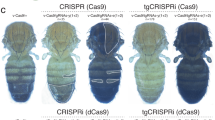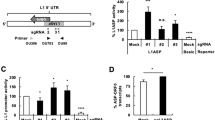Abstract
RNA interference (RNAi) is a powerful tool for studying gene function. We developed an inducible genetic element for short interfering RNA-mediated gene silencing. This system uses a tetracycline (Tet)-responsive derivative of the H1 promoter and the Tet repressor (TetR) for conditional expression of short hairpin RNA (shRNA) in HeLa cells. Promoter constructs were generated, which contain the Tet operator (TetO) derived from a prokaryotic Tet resistance transposon upstream and/or downstream of the TATA box. To quantify the response of controllable transcription units for shRNA expression, we examined the functional activity of polo-like kinase 1 (PLK1), a key component of mitotic progression, that is overexpressed in many human tumors. Cotransfection of plasmids for the expression of TetR and shRNA/PLK1 under the control of an H1 promoter-variant carrying TetO upstream of the TATA box did not alter PLK1 expression and proliferation properties of HeLa cells in the absence of doxycycline. Addition of the antibiotic led to marked downregulation of endogenous PLK1 accompanied by strong inhibition of cellular proliferation. Our data indicate that an inducible transcription system for shRNAs based on the human H1 promoter could be a versatile tool for controlled gene silencing in vitro.
This is a preview of subscription content, access via your institution
Access options
Subscribe to this journal
Receive 50 print issues and online access
$259.00 per year
only $5.18 per issue
Buy this article
- Purchase on Springer Link
- Instant access to full article PDF
Prices may be subject to local taxes which are calculated during checkout






Similar content being viewed by others
References
Blagden SP and Glover DM . (2003). Nat. Cell Biol., 5, 505–511.
Bohme B, VandenBos T, Cerretti DP, Park LS, Holtrich U, Rubsamen-Waigmann H and Strebhardt K . (1996). J. Biol. Chem., 271, 24747–24752.
Brinster RL, Chen HY, Warren R, Sarthy A and Palmiter RD . (1982). Nature, 296, 39–42.
Brummelkamp TR, Bernards R and Agami R . (2002). Science, 296, 550–553.
Carrington JC and Ambros V . (2003). Science, 301, 336–338.
Chong SS, Hu P and Hernandez N . (2001). J. Biol. Chem., 276, 20727–20734.
Danzeiser DA, Urso O and Kunkel GR . (1993). Mol. Cell. Biol., 13, 4670–4678.
Denli AM and Hannon GJ . (2003). Trends Biochem. Sci., 28, 196–201.
Dingermann T, Frank-Stoll U, Werner H, Wissmann A, Hillen W, Jacquet M and Marschalek R . (1992a). EMBO J., 11, 1487–1492.
Dingermann T, Werner H, Schutz A, Zundorf I, Nerke K, Knecht D and Marschalek R . (1992b). Mol. Cell. Biol., 12, 4038–4045.
Elbashir SM, Lendeckel W and Tuschl T . (2001). Genes Dev., 15, 188–200.
Gossen M and Bujard H . (1992). Proc. Natl. Acad. Sci. USA, 89, 5547–5551.
Gossen M, Freundlieb S, Bender G, Muller G, Hillen W and Bujard H . (1995). Science, 268, 1766–1769.
Hannon GJ, Chubb A, Maroney PA, Hannon G, Altman S and Nilsen TW . (1991). J. Biol. Chem., 266, 22796–22799.
Hillen W, Schollmeier K and Gatz C . (1984). J. Mol. Biol., 172, 185–201.
Holtrich U, Wolf G, Brauninger A, Karn T, Bohme B, Rubsamen-Waigmann H and Strebhardt K . (1994). Proc. Natl. Acad. Sci. USA, 91, 1736–1740.
Hynes NE, Kennedy N, Rahmsdorf U and Groner B . (1981). Proc. Natl. Acad. Sci. USA, 78, 2038–2042.
Kassavetis GA, Braun BR, Nguyen LH and Geiduschek EP . (1990). Cell, 60, 235–245.
Lee F, Mulligan R, Berg P and Ringold G . (1981). Nature, 294, 228–232.
Liu X and Erikson RL . (2002). Proc. Natl. Acad. Sci. USA, 99, 8672–8676.
Liu X and Erikson RL . (2003). Proc. Natl. Acad. Sci. USA, 100, 5789–5794.
Lobo SM, Ifill S and Hernandez N . (1990). Nucleic Acids Res., 18, 2891–2899.
Luukkonen BG and Seraphin B . (1998). RNA, 4, 231–238.
Mayo KE, Warren R and Palmiter RD . (1982). Cell, 29, 99–108.
Mittal V, Cleary MA, Herr W and Hernandez N . (1996). Mol. Cell. Biol., 16, 1955–1965.
Murphy S, Pierani A, Scheidereit C, Melli M and Roeder RG . (1989). Cell, 59, 1071–1080.
Myslinski E, Ame JC, Krol A and Carbon P . (2001). Nucleic Acids Res., 29, 2502–2509.
Noonberg SB, Scott GK and Benz CC . (1996). J. Biol. Chem., 271, 10477–10481.
Nouer L . (1991). Heat Shock Response Nouer L (ed). CRC Press: Boca Raton, FL, pp. 167–220.
Ohkawa J and Taira K . (2000). Hum. Gene Ther., 11, 577–585.
Paddison PJ, Caudy AA, Bernstein E, Hannon GJ and Conklin DS . (2002). Genes Dev., 16, 948–958.
Schramke V and Allshire R . (2003). Science, 301, 1069–1074.
Spankuch B, Matthess Y, Knecht R, Zimmer B, Kaufmann M and Strebhardt K . (2004a). J. Natl. Cancer Inst., 96, 862–872.
Spankuch B and Strebhardt K . (2004b). Curr. Pharm. Design (in press).
Spankuch-Schmitt B, Bereiter-Hahn J, Kaufmann M and Strebhardt K . (2002a). J. Natl. Cancer Inst., 94, 1863–1877.
Spankuch-Schmitt B, Wolf G, Solbach C, Loibl S, Knecht R, Stegmuller M, von Minckwitz G, Kaufmann M and Strebhardt K . (2002b). Oncogene, 21, 3162–3171.
Strebhardt K . (2001). PLK (polo-like kinase). Encyclopedia of Molecular Medicine Creighton TE (ed). Wiley and Sons Inc.: New York, NY, pp. 2530–2532.
Sui G, Soohoo C, Affar EB, Gay F, Shi Y, Forrester WC and Shi Y . (2002). Proc. Natl. Acad. Sci. USA, 99, 5515–5520.
Toyoshima-Morimoto F, Taniguchi E, Shinya N, Iwamatsu A and Nishida E . (2001). Nature, 410, 215–220.
van de Wetering M, Oving I, Muncan V, Pon Fong MT, Brantjes H, van Leenen D, Holstege FC, Brummelkamp TR, Agami R and Clevers H . (2003). EMBO Rep., 4, 609–615.
Watanabe Y . (2003). Nat. Cell Biol., 5, 379–382.
Wiznerowicz M and Trono D . (2003). J. Virol., 77, 8957–8961.
Yuan J, Eckerdt F, Bereiter-Hahn J, Kurunci-Csacsko E, Kaufmann M and Strebhardt K . (2002). Oncogene, 21, 8282–8292.
Yuan J, Horlin A, Hock B, Stutte HJ, Rubsamen-Waigmann H and Strebhardt K . (1997). Am. J. Pathol., 150, 1165–1172.
Acknowledgements
This work was supported by grants from the DFG (STR/8-1), the Messer Stiftung, the Sander Stiftung and the Dresdner Bank (Schleicher-, Paul und Ursula Klein-, Manja und Ernst Mordhorst-Stiftung).
Author information
Authors and Affiliations
Corresponding author
Rights and permissions
About this article
Cite this article
Matthess, Y., Kappel, S., Spänkuch, B. et al. Conditional inhibition of cancer cell proliferation by tetracycline-responsive, H1 promoter-driven silencing of PLK1. Oncogene 24, 2973–2980 (2005). https://doi.org/10.1038/sj.onc.1208472
Received:
Revised:
Accepted:
Published:
Issue Date:
DOI: https://doi.org/10.1038/sj.onc.1208472
Keywords
This article is cited by
-
PLK1 has tumor-suppressive potential in APC-truncated colon cancer cells
Nature Communications (2018)
-
MicroRNA miR-509 Regulates ERK1/2, the Vimentin Network, and Focal Adhesions by Targeting Plk1
Scientific Reports (2018)
-
Overexpression of miR-210 and its significance in ischemic tissue damage
Scientific Reports (2017)
-
Cancer stem cell hypothesis: a brief summary and two proposals
Cytotechnology (2013)
-
Toxicity modelling of Plk1-targeted therapies in genetically engineered mice and cultured primary mammalian cells
Nature Communications (2011)



